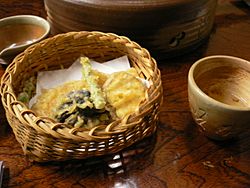Tempura facts for kids
Tempura (which is written as 天ぷら or 天婦羅 in Japanese) is a popular Japanese dish. It's made by lightly frying vegetables or seafood in a special batter until they are crispy and golden. If the tempura is made only with vegetables and no seafood, it's sometimes called shojinage (精進揚げ). This tasty dish actually came to Japan from Portugal! Portuguese sailors brought a similar dish called peixinhos da horta to Japan around the middle of the 1500s.
Contents
How is Tempura Made?
To make tempura, you need a special batter. This batter is usually made from cold water and a light kind of wheat flour. Sometimes, other things like eggs, baking soda, baking powder, or even a little oil are added to make it extra crispy.
Mixing the Batter
The batter is mixed very carefully, often with chopsticks. It's only mixed for a few seconds, and it's okay if there are still some small lumps. This helps the fried tempura get its unique, light, and airy shape. It's important not to mix the batter too much, or it will become chewy and heavy, not light and crispy.
Special Flour and Other Fried Foods
You can find special tempura flour in many supermarkets today. Tempura is different from other fried foods because it doesn't use breadcrumbs, which are called panko in Japan. Foods made with panko are usually called furai, like tonkatsu (fried pork cutlet) or ebi furai (fried shrimp).
Frying the Ingredients
Thinly sliced vegetables or seafood pieces are dipped into the light batter. Then, they are quickly fried in hot oil. Most often, vegetable oil is used, heated to about 160 to 180 degrees Celsius (around 320 to 356 degrees Fahrenheit). How long each piece fries depends on what it is. Very thin vegetables might only need a few seconds, while thicker ingredients or mixed vegetable fritters (called kakiage) might take a few minutes.
Common Ingredients for Tempura
Many different foods can be turned into delicious tempura! Some common seafood choices include shrimp and squid. Popular vegetables are bell peppers, kabocha squash, eggplant, sweet potato, and lotus root. There are many other vegetables and seafood items that can also be used.
How to Enjoy Tempura
Tempura is always served hot right after it's cooked. It's best when it's fresh and crispy!
Dipping Sauces and Salt
Often, a special dipping sauce is served with tempura. The most common sauce is called tentsuyu. It's made from a Japanese soup stock called dashi, a sweet cooking wine called mirin, and soy sauce (shōyu). Sometimes, a special kind of salt is offered instead of sauce.
Tempura in Other Dishes
Tempura can also be used as a topping for hot noodle soups like soba or udon. This adds a delicious crispy texture to the soup.
Images for kids
-
Tentsuyu is the most common sauce consumed with tempura.
-
Peixinhos da horta, the Portuguese ancestor of Japanese tempura
-
shiso tempura
See also
 In Spanish: Tempura para niños
In Spanish: Tempura para niños










